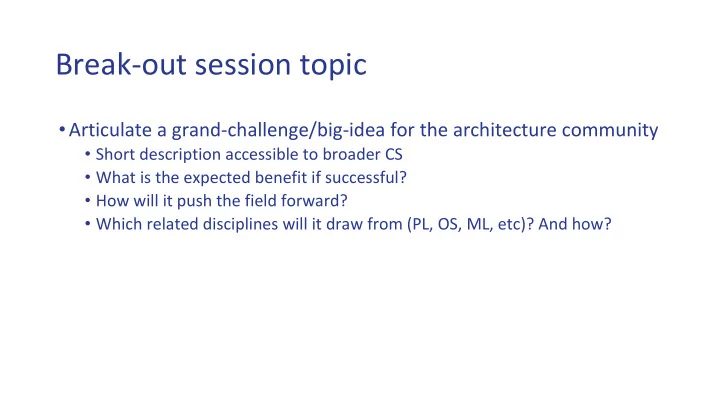

Break-out session topic • Articulate a grand-challenge/big-idea for the architecture community • Short description accessible to broader CS • What is the expected benefit if successful? • How will it push the field forward? • Which related disciplines will it draw from (PL, OS, ML, etc)? And how?
Group 1 Lead: Ras Bodik Christos Kozyrakis, Simha Sethumadhavan, Amrita Mazumdar, Vincent Lee, Mark Hill, Kayvon Fatahalian, Mattan Erez, Lisa Wu, to complete
Democratize software-hardware development Develop hardware fast and collaboratively, just like software. Build working systems with silicon at the bottom. Frtom maker spaces to commercial dev. Expected benefit: Make Hardware Design Great Again Areas that this would revolutionize: 1) IoT (pervasive, distributed, low-power) ○ personal health monitoring 2) ML and science (big data)
Democratize software-hardware development How will this happen? Who will help us? 1) Democratize manufacturing. Like DARPA MOSIS but $1/chip. ( Kickstarter ) 2) Develop repository of modifiable libraries, from CPUs to accelerators ( github ) 3) Compilers to hardware ( CAD ) 4) Domain-specific design languages ( PL ) 5) Analyze hardware designs for privacy, and other properties ( FM )
Group 2 Lead: Joel Emer Kevin Rudd Stavros Volos Anirban Nag Michael Ferdman Karin Strauss Hassan Muhammad Anh Ngo Jack Sampson Mark Silberstein Ping Chi Suleyman Savas Yuan Xie Tulika Mitra Yongpan Liu Timothy Hayes
Reduce cost to solution by N orders of magnitude Defining problem - Ease definition of problems that can be solved with computation - Allow specification of accuracy/tolerance requirements - Allow specification of time (maybe real-time) constraints Expression of ‘program’ - Ease of expression of algorithm (and learned components) - Enable analyzable/predictable systems (taking constraints into account) - Allow expression of approximate computing and security requirements Hardware design - Improve time to design, e.g., adding accelerators Runtime metrics - Reduce cost of computation (including cost-of-ownership) by factor of X - Reduce computation time/energy - Measurement/enforcement of constraints
[Grand challenge title] Pass Turing Test (Societal, Application-driven) Enable personalized medicine/realtime bio-medical introspection (Societal, Application-driven) Reduce time to solution by N orders of magnitude (Advancing computing, enabling more applications) Evaluating approximate computing (Advancing computing) Breach the gap between efficiency and programmability (Advancing computing) Self-organizing computing (Application-driven, advancing computing, ) Achieve N MIPS in human power constraints (Advancing computing) Create a brain-inspired computer (Advancing computing, application-driven?) Enable the Star Trek economy (societal, application-driven) Eliminate crime (societal) Create analyzable/predictable systems (advancing computing) Reduce cost of computation (including cost-of-ownership) by factor of X Create quantifiably tamper-proof systems Create the next parallelism thing
Group 3 Lead: Sarita Adve Matt Sinclair, Mike Taylor, Moyang Wang, Steve Keckler, Aasheesh Kolli, Lide Duan, Dayeol Lee, Boris Grot, Sebastien Raase
Democratizing Specialization - Future systems need to be vertically integrated, specialized - Provide infrastructure/foundation to enable small teams to innovate, design such systems - Redesign the stack around specialization - How to design hardware, express interfaces for other layers? - Systems approach - communication, computation, concurrency, distributed systems
Expected Benefit if Successful Death of Moore’s Law? Whatever! Cambrian explosion of innovative systems True co-design: Software, applications community leverage hardware and vice versa seamlessly
Which Disciplines ALL
Group 4 Lead: Babak Falsafi Alvin Lebeck, Tom Conte, Sungpack Hong, Djordje Jevdjic, Alex Daglis, Josep Torrellas, Lunkai Zhang, Philip Wong, Michael Mishkin, Javier Picorel, Sandhya Dwarkadas
Healthcare On-the-Go (or beyond personalized medicine) What? - 24-hour monitoring, diagnosis, prevention and treatment of disease for individuals What will it buy us? - Improve human condition - Avoid 3-hour lines at ER!
How will it advance the field? · Use of novel devices · Interdisciplinary research/new domain · Human-center design · Interfaces · Biocompatibility · Ultra low-power · Real-time computing · Rethinking of levels of abstraction
What other communities to interface with? · Device technology and circuits · Biomedical engineering (sensors and actuators) · HCI · Computational biology · System software (databases, OS, PL) · Security & privacy · Distributed systems · Real-time computing · Computer Vision/Machine Learning · Theory & algorithms
Group 5 Luis Ceze Lead: David Wood Guangyu Sun Tom Wenisch Jayneel Gandhi Sihang Liu Yipeng Huang Arrvindh Shriraman Akanksha Jain Neha Agarwal Myoeng Jun Joonsung Kim Gilles Pokam Hanhwi Jang Carole Wu
Carbon Negative Computing
Carbon Negative Computing: Problem Problem Definition: * Climate change is a fundamental problem * Computing is making it worse at a fast pace Computing should be part of the solution, not the problem. * Computing should save more carbon than it consumes
Carbon Negative Computing: Solution Direct Impact: Energy-efficient computing * dynamic specialization * approximation Indirect Impact: Using computing to reduce carbon * telecommute vs. physical commute * collective collaboration reduce congestion, zero car accidents Reduce embedded energy: * reduce/eliminate rare earth materials * use carbon nanotubes and biologicals
Carbon Negative Computing: the rest Benefits: * Carbon reduction ⇒ reduce climate change, etc. How will it drive the field? * Problem-driven solutions move more quickly * New interfaces, rapid prototypes Disciplines: * Crossing layers impacts all disciplines
Recommend
More recommend